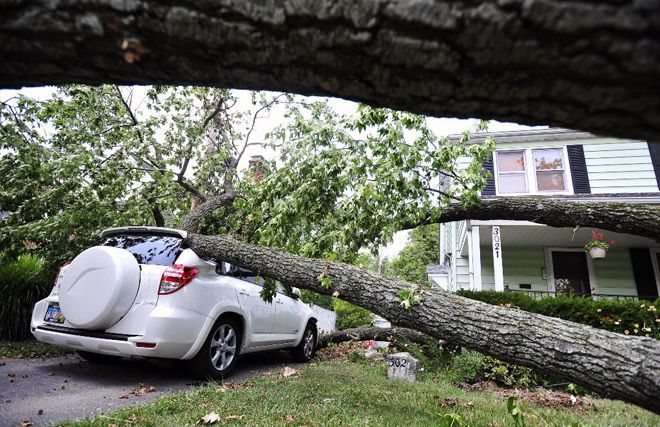
A massive limb crushed a Toyota and took down a number of nearby powerlines in Clintonville, 2012.
An increase in severe weather has led to a doubling of major power outages across
the country in the past decade, according to a new report from a climate-change
research group.
American Electric Power, with its 11-state footprint and largely rural service
territory, has been affected as much or more than any other utility.
It had the most major outages - 42 - of any utility, and it ranked
fourth in the number of customers affected by major outages, 6.6 million.
The study from Climate Central says that severe weather caused
80 percent of the major outages from 2003 to 2013. A major outage is defined
as one that affects at least 50,000 people or interrupts at least 300 megawatts;
1 megawatt can power about 1,000 homes.
"Heat waves are hotter, heavy rain events are heavier, and winter
storms have increased in both frequency and intensity," the report says.
"To date, these kinds of severe weather are among the leading causes of
large-scale power outages in the United States."
The number of major outages was double that recorded during the
prior 10-year period, though the author notes that reporting requirements
have changed, which might be driving some of the increase.
Michigan had the most major outages with 71, followed by Texas
with 57 and Ohio with 54.
AEP has a presence in each of those states. Its service area encompasses
11 states, more than any other utility in the report.
"(Al)most any storm system that moves across the country is going
to hit part of AEP's service area," said AEP spokeswoman Tammy Ridout.
Central Ohio has had several major storms in the past decade that
led to prolonged power failures. The largest were in 2008, when the remnants
of Hurricane Ike crossed the state, and 2012, when the region was hit by
a derecho, a straight-line windstorm.
AEP has spent $1.2 billion since 2009 to make its Ohio systems
more reliable, Ridout said. This includes $310 million for additional tree-trimming,
which can help prevent outages caused when tree branches fall on utility
lines during storms, and $300 million to replace old equipment.
Climate Central, based in New Jersey, describes itself as an independent
research group that reports on climate change. It is one of many groups
that are looking at the potential reasons severe storms appear to be becoming
more frequent and more destructive.
"You can't blame any particular (weather) event on climate change,"
said Steve Clemmer, director of energy research for the Union of Concerned
Scientists. "Climate change is the trend over time, and the problem is
going to get worse over time. What we put into the air is going to be there
for a long time."
His group is about to release its own report about the connections
between severe weather and climate change.
Last month, the Intergovernmental Panel on Climate Change issued
a study that said, in part, that the increasing occurrence of severe weather
could lead to infrastructure breakdowns with far-reaching consequences.
The panel has said that energy production is one of the world's
leading sources of gases that contribute to climate change. Electricity
utilities in the United States are moving away from the dirtiest fuels
and installing equipment to reduce emissions, but there is less of a push
to do so in many other countries.


